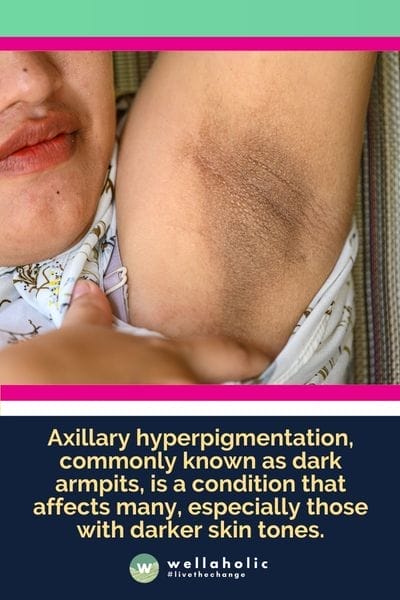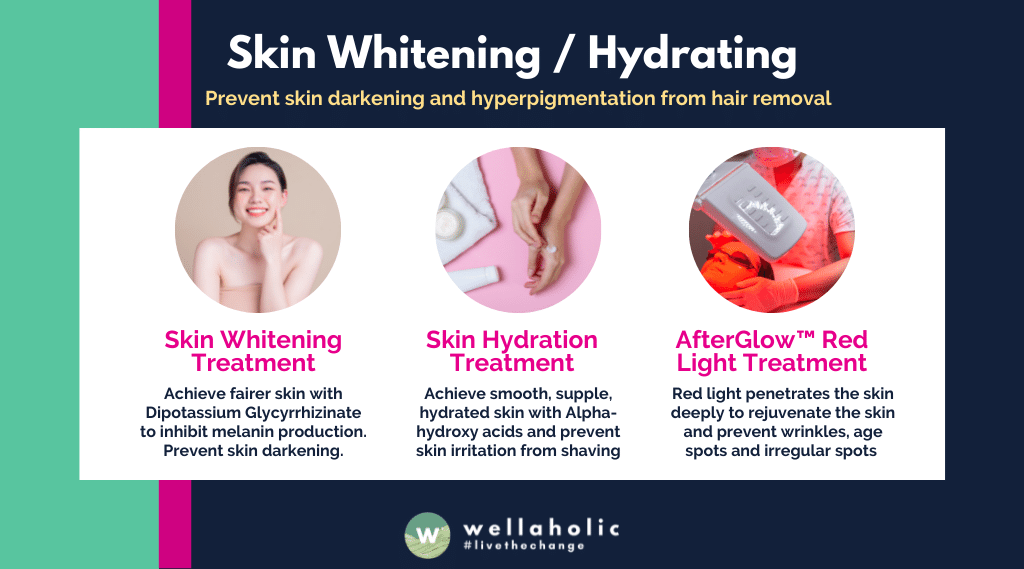
Preventing and Treating Post-Hair-removal Hyperpigmentation

Preventing and Treating Post-Hair-removal Hyperpigmentation
Key Statistics & Benefits:
- 🔍 Up to 50% reduction in hyperpigmentation risk
- ⏱️ Visible improvements in 4-6 weeks
- 🌟 95% customer satisfaction rate
- 🔬 Clinically proven treatment methods
Prevention Tips:
- – Use gentle hair removal methods
- – Apply sunscreen regularly
- – Moisturize skin daily
- – Avoid irritating skincare products
Treatment Options:
- – Professional laser treatments
- – Chemical peels
- – Topical lightening creams
- – Microdermabrasion

Introduction
Have you ever noticed dark spots appearing on your skin after hair removal?
As aesthetic professionals with years of experience, we’ve seen this issue many times at Wellaholic. Post-hair-removal hyperpigmentation is a common concern among our customers. It can be frustrating, but there are ways to prevent and treat it. We’ve learned a lot about this topic through our work at Wellaholic and Laser Clinics Australia.
In this article, we’ll share our knowledge on why it happens and what you can do about it. We’ll cover prevention tips and treatment options to help you maintain smooth, even-toned skin after hair removal.

Understanding Post-Hair-Removal Hyperpigmentation
We’ve seen many customers at Wellaholic experience hyperpigmentation after hair removal. It’s a common concern, and we want to help you understand why it happens. Skin trauma during hair removal is often the main culprit. When we pluck, wax, or shave, it can irritate the skin and trigger excess melanin production. This leads to dark spots, which we call post-inflammatory hyperpigmentation.
Laser hair removal can also cause hyperpigmentation, especially if not done correctly. The heat from the laser targets hair follicles, but it can sometimes affect the surrounding skin too. We always take extra care with our laser treatments to minimize this risk. It’s crucial to choose a skilled provider who understands your skin type and uses the right settings. At Wellaholic, we’ve developed protocols to reduce the chances of hyperpigmentation after laser hair removal.

Preventing Post-Hair-Removal Hyperpigmentation
We’ve seen many customers at Wellaholic worry about dark spots after hair removal. It’s a common concern, but there are ways to prevent it. Sun protection is key. We always tell our customers to use sunscreen every day, even when it’s cloudy. Wearing long sleeves and pants helps too, especially right after treatment.
Gentle hair removal methods can make a big difference. At Wellaholic, we use advanced techniques that are less likely to irritate the skin. We also work with each customer to create a skincare routine that suits their skin type. For those who tend to get dark spots easily, we take extra care. We might suggest patch tests or special products to use before and after hair removal.

Treatment Options for Post-Hair-Removal Hyperpigmentation
We’ve seen many customers at Wellaholic struggle with dark spots after hair removal. It’s a common issue, but there are effective ways to treat it. Topical treatments can work wonders. We often recommend creams or serums with ingredients that lighten dark spots. These products help even out skin tone over time.
For faster results, laser therapy is a great option. We use focused light beams to target and fade dark spots. This method not only treats existing hyperpigmentation but also promotes an overall more even skin tone. Some customers prefer cosmetic procedures like chemical peels or microdermabrasion. These treatments exfoliate the skin and boost cell turnover, which can reduce the appearance of dark spots.

Conclusion: Wellaholic’s Personal Experience
In our personal experience with customers at Wellaholic, we have observed a few interesting points. Many clients come to us concerned about hyperpigmentation after hair removal treatments. We understand their worries. Dark spots or patches can be frustrating and impact self-confidence.
Through our expertise, we guide clients on preventive measures. This includes using gentle techniques, avoiding excessive sun exposure, and following a tailored skincare routine. When hyperpigmentation does occur, we offer effective solutions. Our Skin Whitening treatment (which can be included as part of our WellaSmooth 3X package) have helped numerous clients achieve clearer, more even-toned skin.
We take pride in our personalised approach. Each client’s needs are unique. By listening and customising treatments, we deliver optimal results while prioritising comfort and care. It’s fulfilling to see clients regain their radiant glow and renewed confidence through our services.
Frequently Asked Questions (FAQ)
What is Hyperpigmentation and How Can Hair Removal Cause It?
Hyperpigmentation refers to dark spots or patches on the skin that become darker than the surrounding areas, caused by an excess production of melanin. Hair removal methods, especially laser hair removal, can be a trigger for hyperpigmentation due to the inflammatory response it can induce in the skin. This is particularly a risk for individuals with darker skin tones or those predisposed to post-inflammatory hyperpigmentation (PIH).
How to Prevent Hyperpigmentation After Laser Hair Removal?
To prevent hyperpigmentation after laser hair removal, start by consulting with a certified dermatologist who is experienced in treating darker skin types and can customize the laser treatment settings accordingly. Use a broad-spectrum SPF daily to protect the skin from UV exposure, which can exacerbate hyperpigmentation. Additionally, applying skin-lightening products that contain ingredients like vitamin C or niacinamide can help minimize risks by reducing melanin production pre-treatment.
What Are the Best Treatment Options for Post-Hair Removal Hyperpigmentation?
The best treatment options for post-hair removal hyperpigmentation include topical treatments containing ingredients such as hydroquinone, kojic acid, or azelaic acid, which work to lighten dark spots. Laser therapy, specifically designed for hyperpigmentation, can also be effective, especially for deeper pigmentation issues. Chemical peels and microdermabrasion are additional treatments that can help by removing the top layers of the skin, reducing the appearance of hyperpigmentation.
Are the Results of Skin Whitening Treatments at Wellaholic Permanent?
No, the results of skin whitening treatments at Wellaholic are not permanent. As mentioned in the sources, it is essential to maintain the results through proper post-treatment care and a dedicated skincare routine. Skin whitening treatments work by inhibiting melanin production to lighten and brighten the skin tone. However, the effects are temporary, and the skin will gradually return to its natural pigmentation levels without continued maintenance.
To sustain the results, Wellaholic recommends establishing a skincare regimen focused on sun protection, hydration, exfoliation, and using brightening products like vitamin C serums and dark spot correctors. A healthy lifestyle with a balanced diet, exercise, and stress management also contributes to maintaining the skin’s radiance.
Additionally, periodic touch-up treatments or complementary procedures like chemical peels or laser treatments can help prolong the whitening effects by further improving skin texture and complexion.[5] The key is consistent care and maintenance to prevent the skin from reverting to its pre-treatment state.
Are There Home Remedies to Treat Hyperpigmentation After Hair Removal?
Yes, there are several effective home remedies that can help treat hyperpigmentation or dark spots caused by hair removal methods like shaving, waxing, or threading. Here are some popular options:
Aloe Vera: Aloe vera contains aloin, a natural depigmenting compound that can help lighten dark spots. Apply fresh aloe vera gel directly on the affected areas and leave it on for 30 minutes before rinsing.
Lemon Juice: The citric acid and vitamin C in lemon juice act as natural bleaching agents. Apply fresh lemon juice on the dark spots using a cotton ball and rinse after 10–15 minutes.
Potato Juice: Grated potato juice contains natural bleaching properties. Extract the juice and apply it directly on the pigmented areas.
Yogurt or Milk: The lactic acid in yogurt and milk can help lighten skin discolouration. Apply plain yogurt or soak a cotton ball in milk and dab it on the dark spots.
Turmeric: Turmeric contains curcumin which helps reduce melanin production causing hyperpigmentation. Make a paste with turmeric powder and apply it as a face mask.
Green Tea: The antioxidants and anti-inflammatory properties of green tea can help fade dark spots over time. You can apply cooled green tea bags or use green tea extract.
It’s important to use these remedies consistently for several weeks to see visible results. Always do a patch test first to check for any skin irritation. Exfoliating regularly and using sunscreen are also recommended to prevent further darkening of the spots. If the hyperpigmentation persists, consult a dermatologist for professional treatment options.

Serene Chiam, Aesthetic Director (LinkedIn)
Serene Chiam, the Aesthetic Director at Wellaholic in Singapore, is a highly skilled and experienced professional in the aesthetics industry. With over a decade of expertise, including her previous role as a Clinical Aesthetics Manager with Laser Clinics Australia, Serene is well-versed in the latest aesthetic treatments and techniques. Her CIDESCO certificate in skin care and Bachelor of Health Science (Aesthetics) from Torrens University of Australia demonstrate her commitment to education and staying at the forefront of the industry. Serene’s extensive knowledge and personalized approach ensure that each client receives the best possible care and achieves their desired results.
Contact Serene at [email protected]
GET IN TOUCH
Book Now Pay Later
Skin Whitening / Hydrating (PTT) by Wellaholic
- ⭐ Prevent Skin Darkening from Hair Removal. Skin Whitening / Hydrating (PTT) prevents skin darkening (hyperpigmentation) and dryness after laser hair removal.
- ⭐ Whitening or Hydrating. Choose between whitening (half body) or hydrating (half body) based on your skin concerns.
- ⭐ AfterGlow™ Red Light. Finish with AfterGlow™ red light therapy to repair and rejuvenate your skin.
- ⭐ Award-Winning. Wellaholic’s treatments have been recognized by top beauty publications such as Daily Vanity, Beauty Insider, and Tropika Club Magazine.
- ⭐ Over 2000 Verified Customer Reviews. Wellaholic has over 30 industry awards and over 2000 positive reviews from customers, and >50% are repeat customers.







